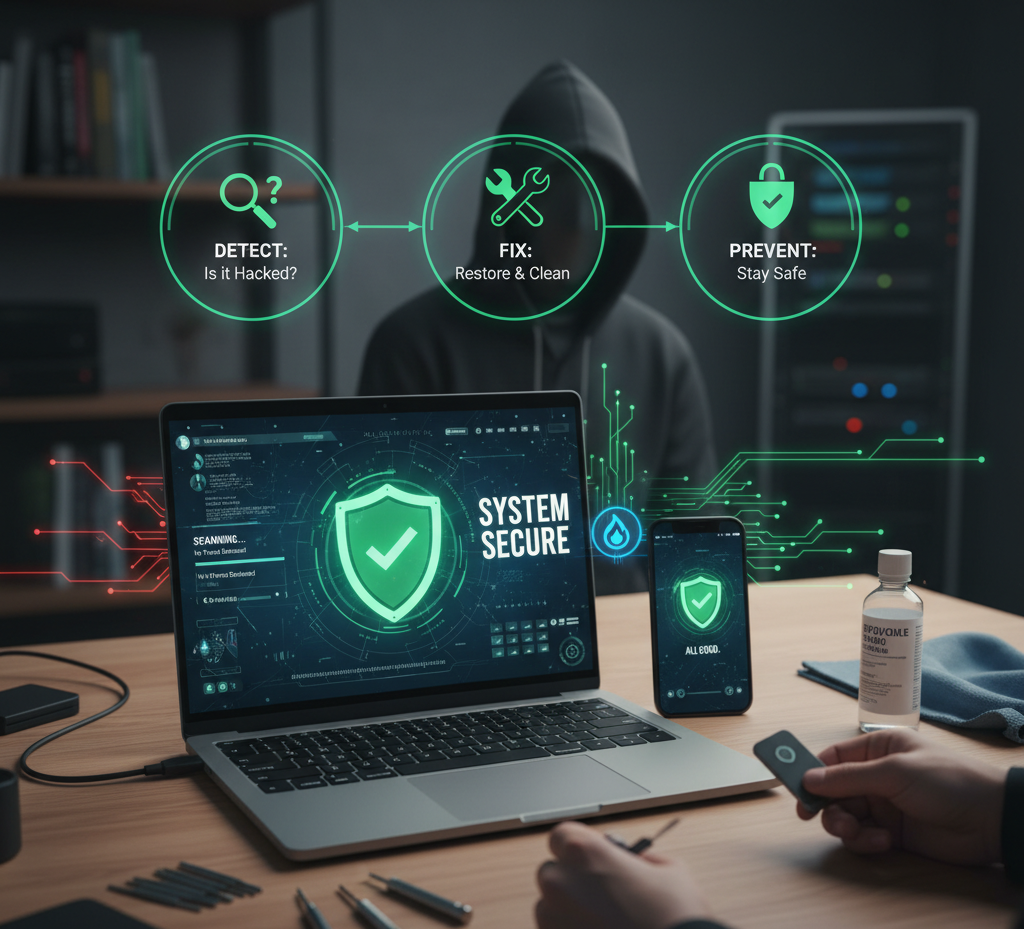Introduction
We live in a hyper-connected world where smartphones and laptops act as extensions of ourselves. From personal banking apps to sensitive work files, these devices carry everything we hold private. That’s why hackers are constantly looking for ways to break in, steal information, and exploit weaknesses.
But here’s the pressing question many people ask: “How can I understand if my phone or laptop is hacked or not — and if hacked, how can we fix it?”
This guide will not only help you recognize the warning signs of hacking but also give you step-by-step solutions to fix a hacked phone or laptop. Finally, we’ll explore how to prevent future hacks, so your digital life stays protected.
Part 1: Signs Your Phone May Be Hacked
Your smartphone is a powerful tool — but also a hacker’s dream if not protected. Here’s how to tell if it’s been compromised:
- Rapid Battery Drain & Overheating – Spyware consumes hidden resources.
- Performance Lag – Apps freeze, load slowly, or crash often.
- Unknown Apps Installed – Suspicious icons appear on your home screen.
- High Data Usage – Hackers use your device to send data or mine crypto.
- Unusual Messages or Calls – Friends receive spam messages from your number.
- Intrusive Pop-Ups & Ads – Adware hijacks your browser.
- Changed Settings Without Permission – Microphone, camera, or location mysteriously turned on.
- Unexpected Charges – Premium-rate calls or SMS charges appear.
- Locked Device / Ransomware Screen – Pay-to-unlock demands indicate serious compromise.
- Call Forwarding or SIM Hijack – Dial codes like
*#21#reveal suspicious forwarding.
Part 2: Signs Your Laptop or Computer May Be Hacked
Laptops and desktops often show more visible hacking symptoms. Look out for:
- Slow System & Frequent Freezes – Malware eats resources.
- Unknown Programs Installed – Unfamiliar apps in your system.
- Browser Redirects & Toolbars – Your search engine or homepage changes.
- Unauthorized Emails Sent – Your email account spams contacts.
- Disabled Antivirus or Firewall – Hackers try to weaken protection.
- Webcam / Mic Activation – Camera light turns on unexpectedly.
- Blue Screen Errors or System Crashes – Deep-level malware causes instability.
- Suspicious Network Activity – Unknown connections run in the background.
- New User Accounts – Hackers create admin access to control your PC.
- Files Encrypted or Missing – Classic sign of ransomware.
Part 3: How to Confirm If Your Device Is Hacked
Not every glitch means hacking, so here’s how to confirm:
- Run Security Scans – Use Malwarebytes, Norton, or Microsoft Defender.
- Check Device Logs – Android/iOS logs and PC event logs reveal suspicious activity.
- Monitor Network Traffic – Use Wireshark or GlassWire.
- Look for Security Alerts – Google, Apple, and Microsoft notify about strange logins.
- Check IMEI & Accounts – Ensure your phone number hasn’t been cloned.
Part 4: How Can We Fix a Hacked Phone or Laptop?
If you confirm suspicious activity, take immediate action:
Step 1: Disconnect from the Internet
Turn off Wi-Fi and mobile data to stop further communication with hackers.
Step 2: Backup Your Important Data
Save essentials to offline storage (not cloud).
Step 3: Run Antivirus and Anti-Malware
Perform deep scans using trusted tools.
Step 4: Remove Suspicious Apps or Programs
Manually delete unfamiliar software.
Step 5: Update Your System
Install the latest OS and security patches.
Step 6: Change All Passwords
Do this from a clean, safe device.
Step 7: Enable 2FA (Two-Factor Authentication)
Protects your accounts even if your password is stolen.
Step 8: Reset or Reinstall OS
For phones — factory reset.
For laptops — reinstall Windows/macOS/Linux.
Step 9: Monitor Your Bank & Email Accounts
Look for unauthorized activity.
Step 10: Seek Professional Help
For severe attacks, consult IT experts or authorities.
Part 5: How Can We Prevent Future Hacks?
The best fix is prevention. Build cyber hygiene habits:
- Keep your software updated.
- Install apps only from trusted sources.
- Use a VPN on public Wi-Fi.
- Set strong, unique passwords.
- Regularly run malware scans.
- Turn off Bluetooth, NFC, and Remote Access when unused.
- Use password managers like 1Password or Bitwarden.
- Always enable biometric authentication.
Part 6: Tools to Help Protect Devices
- Phones: Malwarebytes Mobile, Avast Mobile Security, Lookout Security.
- Laptops: Norton 360, Kaspersky, Microsoft Defender.
- Network: GlassWire, Wireshark.
- Passwords: Bitwarden, LastPass, 1Password.
Part 7: FAQs
Q1: Can my phone be hacked remotely?
Yes, through spyware apps, phishing links, or network attacks.
Q2: Can hackers listen to my calls?
If spyware is installed, they may monitor conversations.
Q3: Will a factory reset remove hackers?
Usually yes, but rare advanced malware may persist.
Q4: How often should I check for hacks?
At least weekly scans and daily vigilance.
Conclusion
Your phone and laptop are your digital lifelines — but also prime hacking targets. Recognizing early signs of hacking can prevent massive losses.
Now you know:
- How can I understand if my phone/laptop is hacked or not
- How can we fix a hacked device
- How can we prevent hacks in the future
The key is vigilance, quick action, and strong prevention habits. Cybersecurity isn’t a one-time effort — it’s an ongoing practice.
Stay safe. Stay smart. Stay unhackable.



